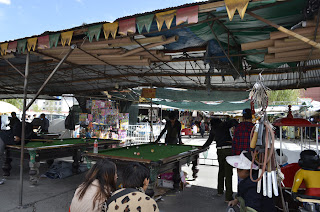I apologize for the hiatus in my writing. I was inadvertently involved in my first Facebook flame war this past weekend and it did not end so well. I will only say three things on the subject:
1. If you have a problem with me, take it to a private place.
2. If you persist in attacking me in my public venue, please be civil.
3. If you continue to attack me, at least have the courtesy to actually read my responses and try to find out what happened before jumping to conclusions and projecting your own frustrations onto me.
Now onto the actual post!
There is an island off of Lhasa known in Tibetan as Thieves' Island (Kumalingka, although there are a variety of ways to transliterate it) and in Chinese as Sun Island (Taiyang Dao). The river that separates it from the mainland is barely a river, it is more like a stream so its status as an island is debatable. It is also an extremely small area with literally around four or five major streets, two of which are called Sun Island Road 1 and Sun Island Road 2. No mental gymnastics required here.
Anyway, Kumalingka has always been described to me as a gambling area and I was very curious to see a different part of Lhasa. When we were trying to figure out how to tell the cab driver where to go, we found out that the name of this island differed drastically between Tibetan and Mandarin. My guess is that the Chinese are trying to make the island seem happy and welcoming, hence the Sun label. Personally I prefer Thieves; makes it seem more mysterious.
After crossing an overly large and ostentatious bridge, the first sights you will be greeted with are large resort hotels. There is also an area with rows upon rows of clothing stores with brand name labels such as: FHJY and Made in China.
 |
| I wasn't joking. |
This area is very distinct from the streets around the Barkhor and the Jokhang. Those streets are winding with bricked white walls and have a very Tibetan feel, especially with the architecture. Here it feels more Chinese. The blocks of stone and layered facade of Tibetan buildings isn't seen very often. The stores are reminiscent of cities like Chengdu and Shanghai.
One of the main attractions here is clearly marketed towards tourists since it is a theater that boasts extra oxygen.
There are also a ton of bars and KTV centers around this area, so if you are looking to get your drink and song on, this is the place to go!
Another noteworthy bit of information is that I have heard that parts of this island are known for... female companionship. If that's what you are into, it is allegedly available here.
Tibetan mastiffs are huge as pets here and I always thought it was strange that I didn't see many breeders or pet sellers within Lhasa. Most advertise their farms and kennels on the outskirts. As I was discussing this with the Boy, we rounded the corner of Sun Island Road 2 and saw a street full of mastiffs for sale. These ranged from puppies to grown adults, primped in their red collars. I have thus renamed this street Mastiff Road.
If you wanted to pick up a mastiff for cheap, go here. I asked about prices, just out of curiosity, and the adults were offered for 100 yuan and above. This is definitely a departure from the hundreds of thousands of dollars that are spent on pedigreed dogs: article on Mastiff prices.
 |
| I assume they will be more expensive if you call this number |
I was a little confused about the puppies. They were only 70 yuan but the man who was telling me the prices differentiated between the puppies and the grown mastiffs. I couldn't tell if he meant that the puppies were mutts, that because they were puppies they were cheaper, or that they weren't even mastiffs at all. In any case, it was pretty hard to walk away from these dogs...
Across from these mastiffs are rows of actual pet stores selling other purebred dogs like golden retrievers and Pomeranians. This is also where the pet food seems to be sold.
Finally, the last major attraction that I saw on Thieves' Island was a carnival. It had all sorts of rides and plenty of people to enjoy the day. They even sold cotton candy and sweet kettle corn. It seemed like a lot of fun and I plan to return to enjoy the go carts.
 |
| Sorry if this is a little blurry. I had to squeeze my lens into a hole between the wires. |
If you are ever in Lhasa, I highly recommend visiting Thieves' Island, if only for something really different.




































































